Using Conditional Formatting Rules for Tracking Changes Between Snapshots for Version 7.2
Contents
- 1 Introduction
- 2 Overview
- 3 Change Tracking Using the Conditional Formatting for Tasks & Milestones Form
- 4 Change Tracking Using the Conditional Formatting for Text Columns & Rows Form
- 5 Change Tracking Using the Conditional Formatting for Swimlanes Form
- 5.1 Has Changed Operator – Swimlane Name Label Cells and Swimlanes
- 5.2 Has Changed Operator Example – Swimlane Name Label Cell and Swimlane
- 5.3 Has Not Changed Operator – Swimlanes Name Label Cells and Swimlanes
- 5.4 Tracking Changes for Other Imported Data Column Types – Swimlane Name Labels and Swimlanes
- 6 Data-Driven Task Links Using the Has Changed and Has Not Changed Operators
- 7 Related Links
Introduction
Illustrations used in this article are from OnePager Pro using data from Microsoft Project but the features, function, controls, and manual edits apply equally to other OnePager editions that import from data sources like Microsoft Excel, Smartsheet, Oracle Primavera P6, Project for the Web, Planisware Enterprise, Asana, and Wrike.
Change tracking between snapshots is an enhanced feature implemented in Conditional Formatting Rules forms provided with OnePager for these classes of objects:
- Task Bar/Milestone Symbol Decorations
- Text Columns and Rows
- Swimlanes
- Task Links
The purpose of this article is to introduce the new change tracking between snapshots feature, how it’s implemented in existing and new conditional formatting rules forms, and provide some examples of how it can be used to highlight your chart in schedule conversations.
Overview
Snapshots are OnePager charts that are sequenced in time and created from time-phase imports from your project’s schedule source plan. OnePager can have any number of snapshots associated with a particular named chart file. From the OnePager Chart Editor you can navigate between snapshots using the OnePager tool bar View tab’s Snapshots section’s controls.
For more information specifically on snapshot concepts, please see the articles listed in the table below:
| Understanding Charts and Snapshots for OnePager |
| OnePager's Ribbon Tool Bar Tabs |
| Snapshots (Versioning) |
Since projects change over their life time such as changes to Start dates and Finish dates, Percent Complete values, and Actual Costs, as examples, it is important to be able to visualize how a project changes over time. The Change Tracking feature allows you to create visual changes in the chart specifically to highlight changes of interest between snapshots. The controls for visualizing these snapshot to snapshot changes are implemented in the three sets of conditional formatting rules forms described above.
You have the option in conditional formatting rules forms to establish a rule that contains one of two new options. These new operator options are:
- Has changed
- Has not changed
Using any imported field from your source plan you can establish rules that clearly show when a project changed between two adjacent snapshots.
This article contains three parts each devoted to explaining the use of the change tracking feature as it is implements in the three conditional formatting rules forms available in all editions of OnePager. We first start out with the Conditional Formatting for Tasks & Milestones form, then describe the feature available in the Conditional Formatting for Text Columns & Rows form, and finish up with a discussion of the features in the Conditional Formatting for Swimlanes form. In addition to these three Conditional Formatting Rules categories, OnePager can track changes between snapshots with respect to Task Links as well. This subject is discussed in the last major section of this article.
Change Tracking Using the Conditional Formatting for Tasks & Milestones Form
As you’ll see in this sub-section, the former Conditional Formatting Rules form is enhanced and now contains additional columns for you to have a choice between the Basic and Advanced sets of columns when you access the form.
For more information on the Conditional Formatting for Tasks & Milestones form which replaces the Conditional Formatting Rules form prior to OnePager Version 7.2, please see the article at the link below:
| Conditional Formatting Rules for Task Bar/Milestone Symbol Decorations |
The Change Tracking Feature is implemented in all editions of OnePager through the addition of two (2) new operator options that are available in the Operator column in the grid of the Conditional Formatting Tasks & Milestones form shown below:
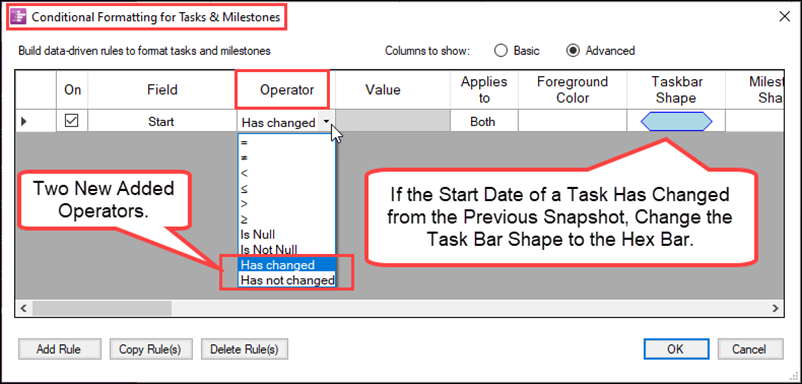
Has Changed Operator – Tasks & Milestones
In the illustration above, the Has changed operator is selected and applied to the Start date field in the source plan. What OnePager does when a new snapshot is created or updated, is examine, in this case, the Start date value of all imported tasks and, if a Start date has changed, changes the task bar shape to the Hex Bar as shown above in the Taskbar Shape column of the Conditional Formatting for Tasks & Milestones form.
Has Changed Operator Example – Tasks & Milestones
Suppose we have a portion the BlueGrass Project chart shown below with Task bar Name Labels, Start Dates, and Finish Dates displayed:

Suppose we want to create a new snapshot where the Finish Date for the Create Working Plans task has changed from 12/3/18 to 12/20/18. To accomplish this, we can create a Conditional Formatting for Tasks & Milestones rule for the purpose of this example such as the one shown below:
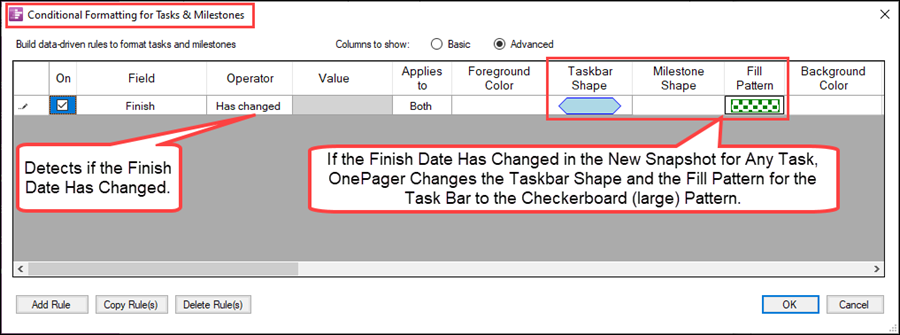
If the source plan is updated to change the Finish Date for the Create Working Plans task bar and you add a new snapshot for an update at a later date, since a Finish Date in the added snapshot is changed, the updated chart looks like this:

To compare the new snapshot with the previous snapshot, go to the OnePager tool bar View tab and click the Previous arrow button in the Snapshot section of the tab. This action takes you back to the previous snapshot where the Finish Date, by definition, has not changed and the original Taskbar shape and Fill Pattern are displayed as shown here:

If we take this example one step further by assuming that the Finish Date for the Created Working Plans task has not changed when we create the next snapshot in the series of three (3), we see that the task bar shape for the Create Working Plans task bar has reverted back to the rectangular task bar shape as shown below:

If, as the project progresses, Finish Dates change for any imported task in future new snapshots and the Conditional Formatting for Tasks & Milestones rule is still active, OnePager changes the Taskbar shape and Fill Pattern from that of the previous snapshot.
This new OnePager feature is ideal for drawing attention to changes that have occurred in the project from the previous snapshot.
Has Not Changed Operator – Tasks & Milestones
The Has not changed operator functions in the same way as in the previous example although the sense of the change is reversed. The utilization of the Has not changed operator is in those situations where there is a need to highlight a task bar(s)/milestone symbol(s) that should have changed in some way but have not.
Has Not Changed Operator Example – Tasks & Milestones
For example, suppose you want to highlight task bars/milestone symbols whose Percent Complete value has not changed from a previous snapshot using the chart shown below:

As an example, using the same project chart we can create a Conditional Formatting for Tasks & Milestones rule that looks like this:
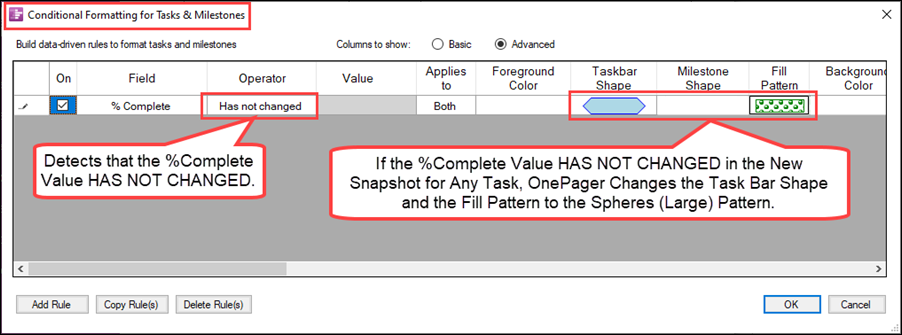
Suppose, for example, that the next snapshot is taken after the Assemble Resources task bar is at a % Complete value of 70% and the MERLIN Subcontractor Selection task bar is at 100% Complete. When the next snapshot is created, it looks like the illustration below:

As shown above, the two task bars that Have not changed %Complete values are shown with the Hex bar Taskbar shape and the Spheres (Large) Fill Pattern. In this way you can highlight task bars/milestone symbols that are not making progress as part of your schedule conversation.
As a reminder, of the discussion in the previous sub-section above, if there is a change in a task bar’s property value under the control of a Conditional Formatting Rule in the next snapshot, the changed properties revert generally to their default values.
Tracking Changes for Other Imported Data Column Types – Tasks & Milestones
The Has changed and Has not changed operators are available for all imported data column types recognized by OnePager. These include:
- Text Strings
- Dates
- Numeric Values
- Boolean
The operator column dropdown list of options for these various imported data column types are shown below:
Text String Columns
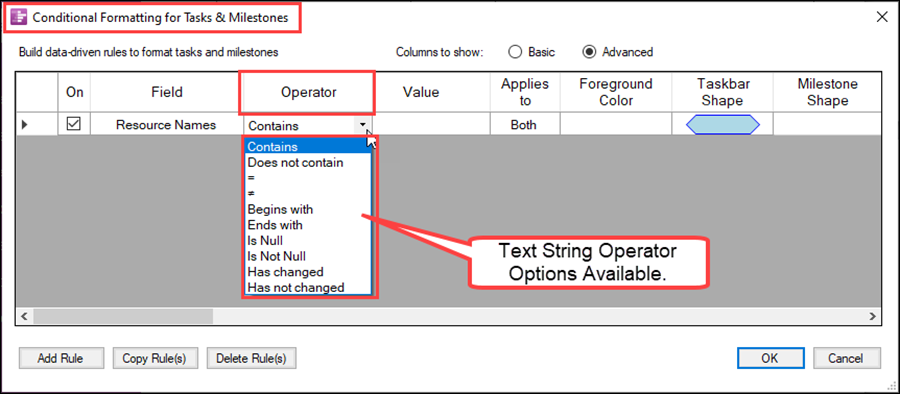
Date Columns
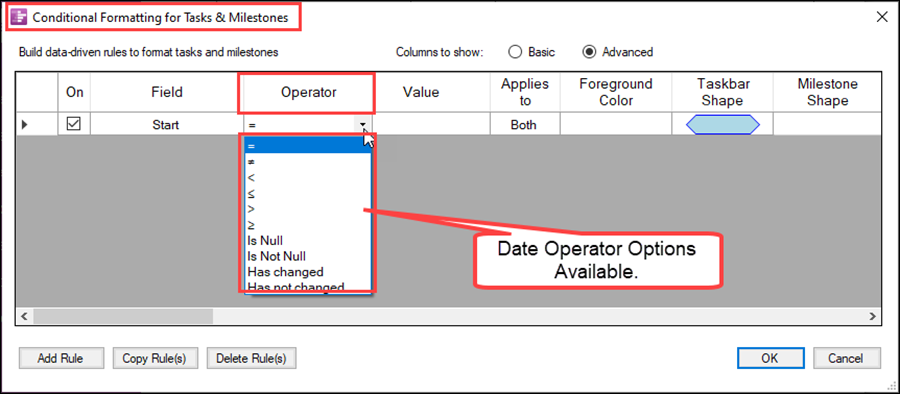
Numeric Columns
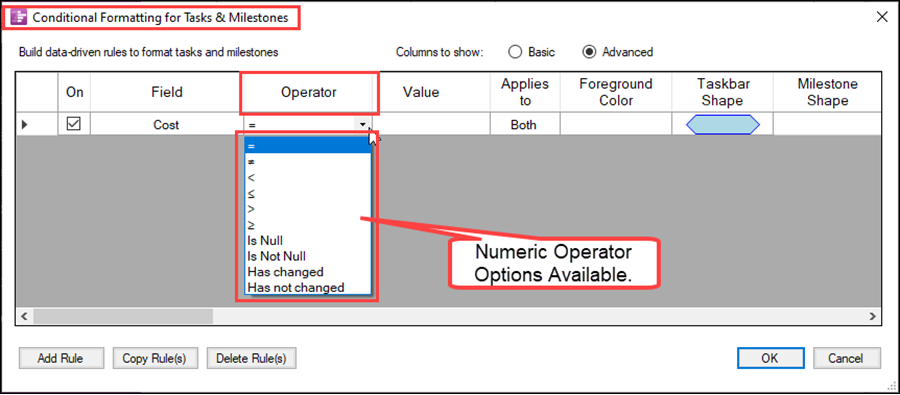
Boolean Columns
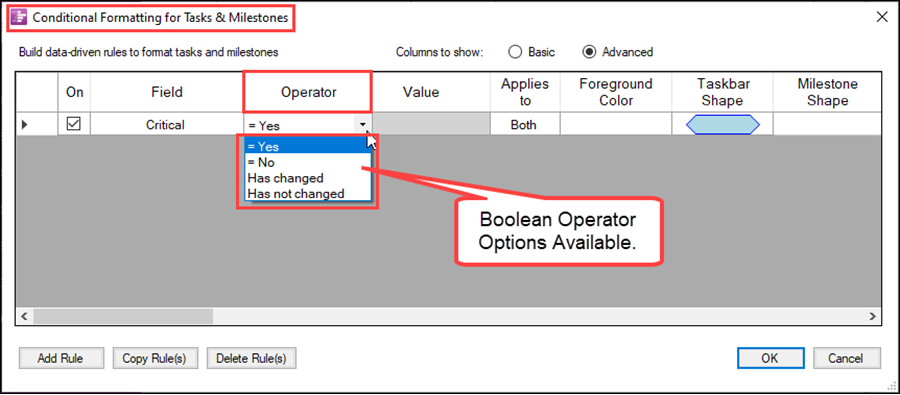
Change Tracking Using the Conditional Formatting for Text Columns & Rows Form
The Conditional Formatting for Text Columns & Rows form supports an enhanced feature where you can apply conditional formatting rules to enhance text column cells for any and all of the five (5) text columns supported by OnePager. Additionally, you have the capability to apply conditional formatting rules to row properties as well.
For more information on the Conditional Formatting for Text Columns & Rows form, please see the articles at the link below:
| Conditional Formatting Rules for Text Columns and Rows |
| Using Functions with Text Columns, Rows, and Swimlanes |
The Change Tracking Feature is implemented in all editions of OnePager through the addition of two (2) new operator options that are available in the Operator column in the grid of the Conditional Formatting Text Columns & Rows form shown below:
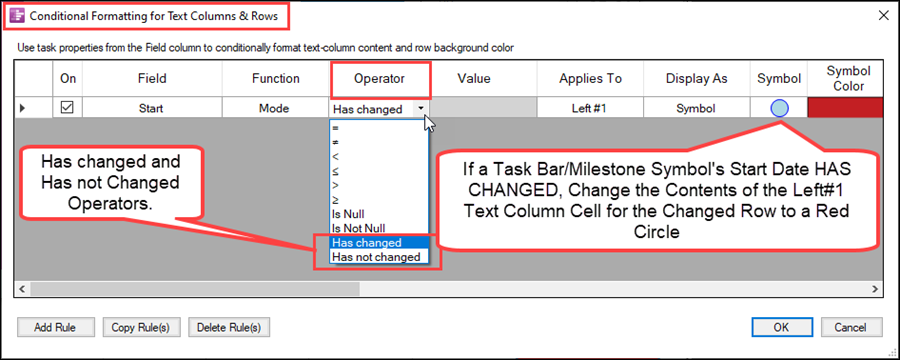
Has Changed Operator – Text Column Cells and Rows
In the illustration above, the Has changed operator is selected and applied to the Start date field in the source plan. What OnePager does, when a new snapshot is created or updated, is examine, in this case, the Start date value of all imported tasks and, if a Start date has changed, change the task bar shape to a Red Circle in the Left#1 Text Column cell in the row with the task bar carrying the changed Start Date as shown above in the Symbol and Symbol Color columns of the Conditional Formatting for Text Columns & Rows form.
Has Changed Operator Example – Text Column Cells
Suppose we have a portion the BlueGrass Project chart shown below with Task bar Name Labels, Start Dates, %Complete with a Left#1 Swimlane and Left#1 and Left#2 Text Columns displayed:

Suppose we want to create a new snapshot where the Start Date for the Create Working Plans task has changed from 10/11/18 to 1/11/19. Further, we want the change to show in the chart by a change to the Left#1 Text Column cell changing from its present Start Date content to a Red Circle. To accomplish this, we can create a Conditional Formatting for Text Columns & Rows rule as the one shown below:
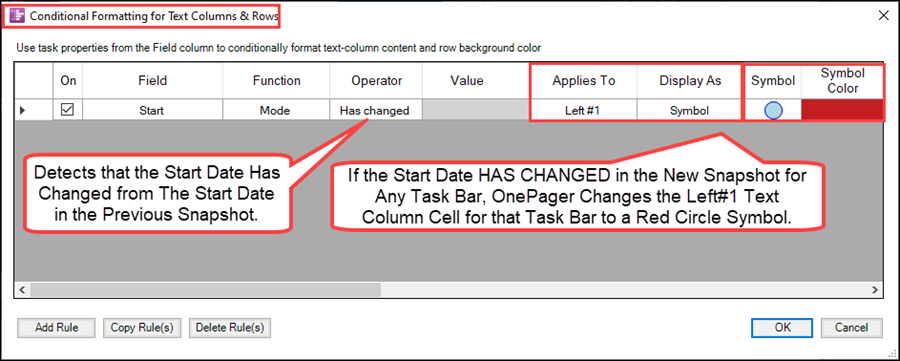
If the source plan is updated to change the Start Date for the Create Working Plans task and you add a new snapshot for an update at a later time, since the Start Date has changed from the date in the previous snapshot, the updated chart looks like this:

To compare the new snapshot with the previous snapshot, go to the OnePager tool bar View tab and click the Previous arrow button in the Snapshots section of the tab. This action takes you back to the previous snapshot where the Start Date, by definition, has not changed and the original Left#1 Text Column cell are displayed as shown here:

If we take this example one step further by assuming that the Start Date for the Created Working Plans task has not changed when we create the next snapshot in the series of three (3), we see that the Left#1 Text Column cell for the Create Working Plans task bar has reverted back to the Start Date value as shown below:

If, as the project progresses, Start Dates change for any imported task in future new snapshots and the Conditional Formatting for Text Columns & Rows rule is still active, OnePager changes the Left#1 Text Column cell from that of the previous snapshot.
This new OnePager feature is ideal for drawing attention to changes that have occurred in the project from the previous snapshot.
Has Changed Operator Example – Rows
The same technique used in the previous example for Text Column cells can be applied to Rows as well. Suppose, as with the previous example, we which to change the Background Color of a row where the task bar’s Start Date has changed from a previous snapshot. To accomplish this, we change the previous Conditional Formatting for Text Columns & Rows rule to the rule shown below:

In the illustration above, text related columns are DISABLED when the Nothing option is selected in the Display As column. Selecting the Nothing option ENABLES the Cell Background column and Row Background column.
When you click the OK button on the Conditional Formatting for Text Columns & Rows form and OK on the Chart Properties form, the second snapshot in the series looks like this:

In the second snapshot, since the modified Conditional Formatting for Text Columns & Rows rule has Row Background Color as the Action Condition, the row containing the Create Working Plans task bar is colored red which includes the two text columns defined in the chart.
Has Changed Operator Example – Text Column Cells and Rows
You can also employ Action Conditions for both Text Columns and Rows by selecting either Text or Symbol in the Display As column of the Conditional Formatting for Text Columns & Rows form. If you change the Conditional Formatting for Text Columns & Rows rule to the example shown below, you can impact both the designated Text Column cell and the Row’s Background color:

When you click the OK button on the Conditional Formatting for Text Columns & Rows form and OK on the Chart Properties form, the second snapshot in the series looks like this:

Has Not Changed Operator – Text Column Cells & Rows
The Has not changed operator functions in the same way as in the previous examples although the sense of the change is reversed. The utilization of the Has not changed operator is in those situations where there is a need to highlight a Text Column and/or Row that should have changed in some way and has not.
Tracking Changes for Other Imported Data Column Types – Text Column Cells & Rows
The Has changed and Has not changed operators in the Conditional Formatting for Text Columns & Rows form with respect to OnePager imported data types are the same as are available in the Conditional Formatting for Tasks & Milestones form covered in the previous sub-section of this article above and is not repeated here.
Change Tracking Using the Conditional Formatting for Swimlanes Form
The Conditional Formatting for Swimlanes form supports a new feature where you can apply conditional formatting rules to enhance swimlane label cells for any and all of the three (3) swimlanes supported by OnePager. Additionally, you have the capability to apply conditional formatting rules to swimlane properties as well.
For more information on the Conditional Formatting for Swimlanes form, please see the article at the link below:
| Conditional Formatting Rules for Swimlanes |
| Using Functions with Text Columns, Rows, and Swimlanes |
The Change Tracking Feature is implemented in all editions of OnePager through the addition of two (2) new operator options that are available in the Operator column in the grid of the Conditional Formatting for Swimlanes form shown below:
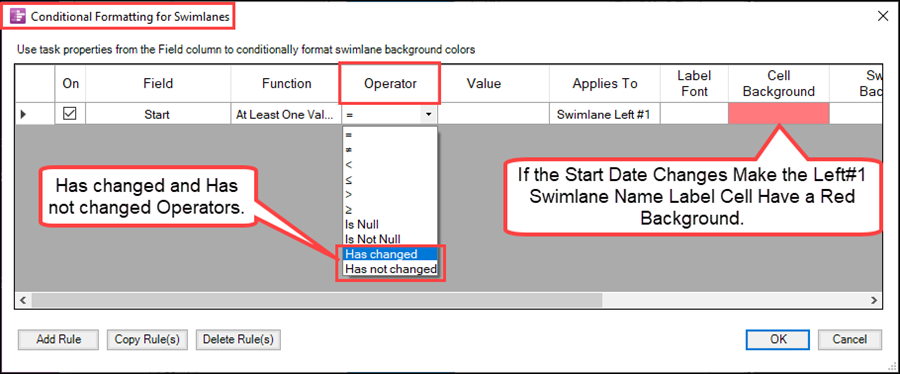
Has Changed Operator – Swimlane Name Label Cells and Swimlanes
In the illustration above, the Has changed operator is selected and applied to the Start date field in the source plan. What OnePager does, when a new snapshot is created or updated, is examine, in this case, the Start date value of all imported tasks and, if At Least One Value for the Start date has changed, change the Left #1 Swimlane Cell Background color to Red in the Left#1 Swimlane Name Label cell in the swimlane with the task bar with the changed Level 1 summary name as shown above in the Cell Background column of the Conditional Formatting for Swimlane form.
Has Changed Operator Example – Swimlane Name Label Cells
As an example, suppose we change the Start date for the Assemble Resources task bar in the Planning Phase swimlane. When we make this change to the source plan and create a second snapshot, the chart looks like this:

Although not shown as an example here, you have the capability to use the swimlane name label’s font properties in the same manner as illustrated for the swimlane name label background color.
Has Changed Operator Example – Swimlanes
The same technique used in the previous example for Swimlane Name Label Cells can be applied to Swimlanes as well. Suppose, as with the previous example, we which to change the Background Color of a swimlane where the task bar’s Start Date has changed from a previous snapshot. To accomplish this, we change the previous Conditional Formatting for Swimlanes rule to the rule shown below:
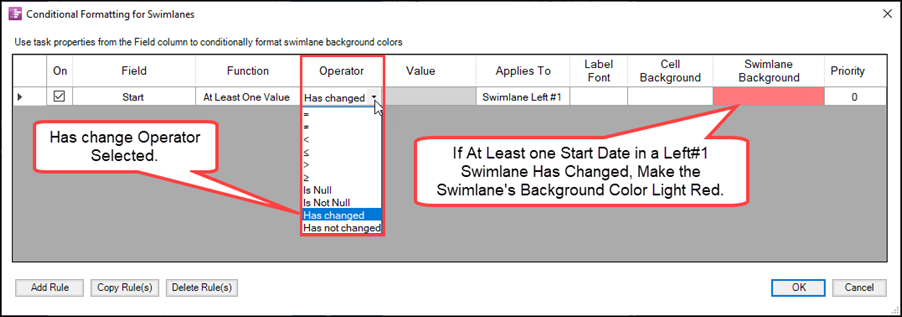
When you click the OK button on the Conditional Formatting for Swimlanes form and OK on the Chart Properties form, the second snapshot in the series looks like this:
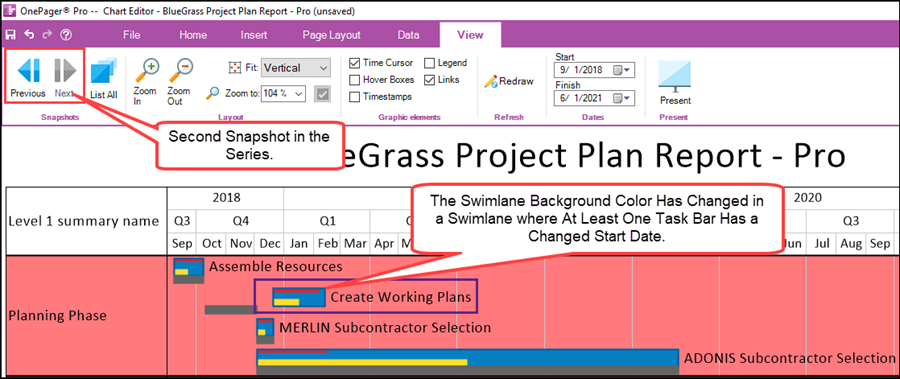
In the second snapshot, since the modified Conditional Formatting for Swimlanes rule has Swimlane Background Color as the Action Condition, the Swimlane containing the Create Working Plans task bar is colored red which includes the swimlane name label cell defined in the chart.
Has Changed Operator Example – Swimlane Name Label Cell and Swimlane
You can also employ Action Conditions for both Swimlane Name Label Cell and Swimlane by entering a Cell Background color and Swimlane Background color in the Conditional Formatting for Swimlanes form. When using this technique it is advisable to select different colors as shown in the example below:
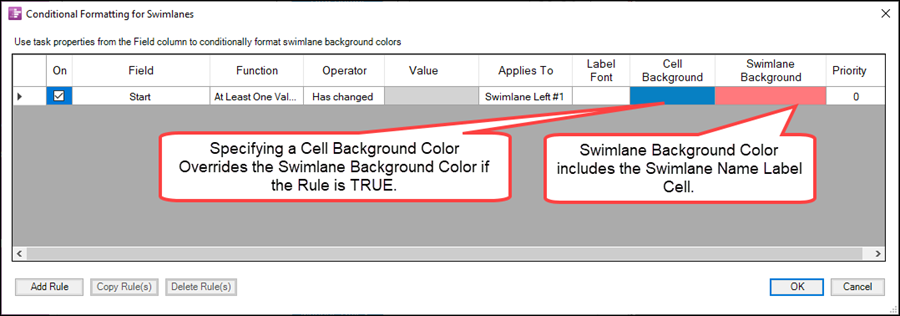
When you click the OK button on the Conditional Formatting for Swimlane form and OK on the Chart Properties form, the second snapshot in the series looks like this:
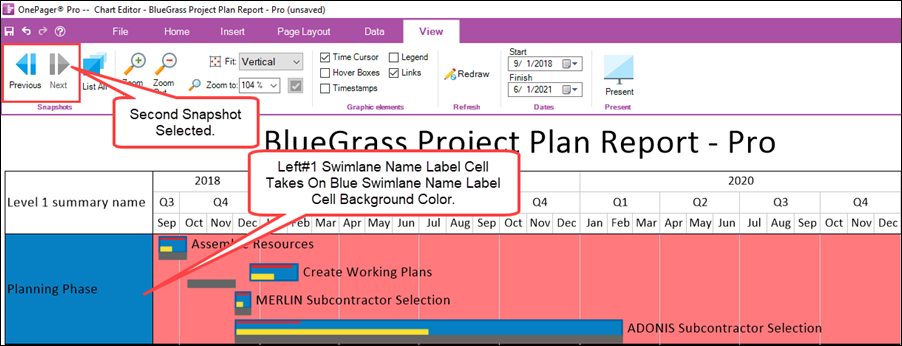
Has Not Changed Operator – Swimlanes Name Label Cells and Swimlanes
The Has not changed operator functions in the same way as in the previous examples although the sense of the change is reversed. The utilization of the Has not changed operator is in those situations where there is a need to highlight a Swimlane Name Label Cells and/or Swimlanes that should have changed in some way and has not.
Tracking Changes for Other Imported Data Column Types – Swimlane Name Labels and Swimlanes
The Has changed and Has not changed operators in the Conditional Formatting for Swimlanes form with respect to OnePager imported data types are the same as are available in the Conditional Formatting for Tasks & Milestones form covered in a previous sub-section above and is not repeated here.
Data-Driven Task Links Using the Has Changed and Has Not Changed Operators
In addition to their use in the three (3) Conditional Formatting Rules forms, the Has changed and Has not changed operator options are available in the Task Link Filter Rules form which controls the showing and hiding of Data-Driven Task Links based on the values of imported data columns from the source plan.
The Change Tracking Feature is implemented for Task Link in all editions of OnePager through the addition of two (2) new operator options that are available in the Operator column in the grid of the Task Link Filter Rules form shown below:
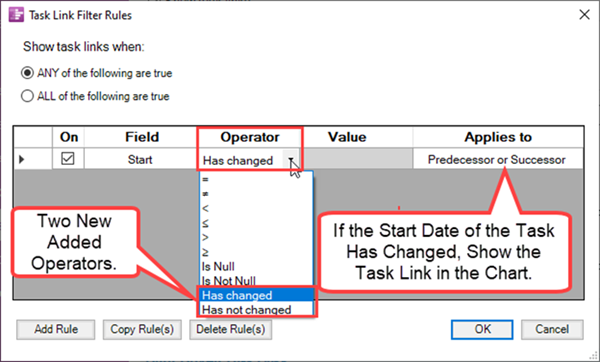
Has Changed Operator – Task Link Filter Rules
In the illustration above, the Has changed operator is selected and applied to the Start date field in the source plan. What OnePager does, when a new snapshot is created or updated, is examine, in this case, the Start date value of all imported tasks and, if a Start date has changed, OnePager shows the changed task bar/milestone symbol’s task link in the chart. Otherwise, the task link is not shown.
Has Changed Operator Example – Task Link Filter Rules
As an example, suppose we change the Start date for the Assemble Resources task bar. When we make this change to the source plan and create a second snapshot, the chart looks like this:

In the example above, the task link appears after the Start date for the predecessor task bar has changed. This is a way to visualize what downstream task bars are impacted by a Start date change.
Has Not Changed Operator – Task Link Filter Rules
The Has not changed operator functions in the same way as in the previous examples although the sense of the change is reversed. The utilization of the Has not changed operator is in those situations where there is a need to highlight a Task Link that should have changed in some way and has not.
Related Links
(11.3.3-72)